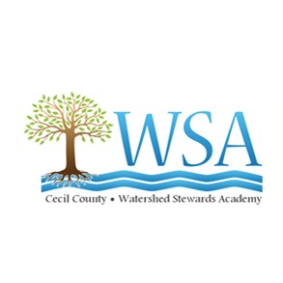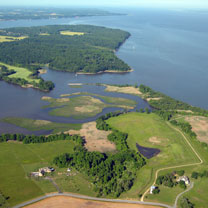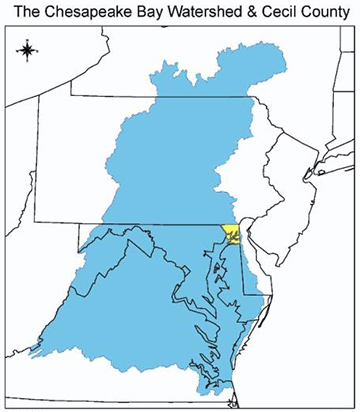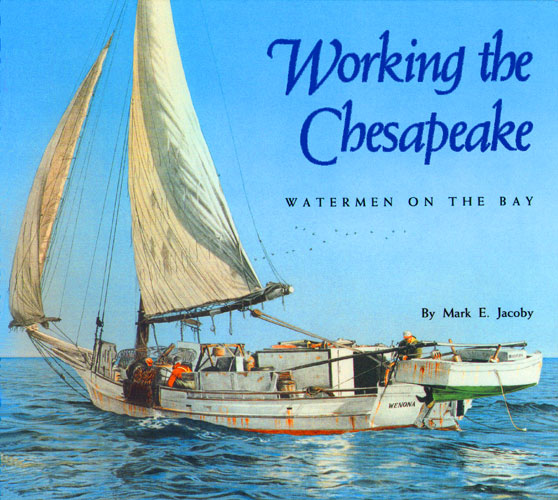Knauss legislative fellowships in Congress help build careers — and they're fun and educational. See our video and fact sheet for details.
Cecil County Establishes First Watershed Stewards Academy on Eastern Shore

Applications Accepted for First Class
Cecil County is the newest location in Maryland, and the first on the Eastern Shore, to offer a special class that trains volunteers to help carry out local projects to reduce flows of polluted stormwater into the Chesapeake Bay.
Extension specialists from Maryland Sea Grant helped to establish the Cecil County Watershed Stewards Academy, which is now accepting applications. It’s modeled on similar, successful efforts in Anne Arundel and Howard counties and the Washington, D.C., area that have trained a total of 150 “master stewards.”
Stewards-in-training receive instruction and hands-on experience in planning and carrying out local projects to control stormwater runoff and to reduce its flow into the Bay. The runoff can carry with it excess nutrients and pollutants that harm the estuary's water quality. The projects include installing rain gardens that trap stormwater runoff before it flows into streams. The students also learn about the science behind watershed restoration.
Cecil County’s academy will run from September to April. Classes will be held one night a week at the Cecil County administration building in Elkton. The program will charge each student an enrollment fee of $150 per person to help defray the cost of course materials. Scholarships are available.
 |
| Pond Creek, near Elk River, Cecil County, Md. Photo: Ben Longstaff |
Jennifer Dindinger, a watershed restoration specialist at Maryland Sea Grant Extension, worked with Cecil County environmental groups and the county’s Development Services Division to establish the academy. “We figured out a model for the new program based on the western shore academies already in place,” Dindinger says. “Cecil County government staff were interested and involved in the process from the beginning.” The program will receive funding from Cecil County, University of Maryland Extension, and the Chesapeake Bay Trust.
The Cecil County academy will follow a curriculum similar to that used in the western shore programs and will also explore differences in land management between the regions. “Cecil County has a unique mix of urban and rural landscapes that set it apart from the other locations where stewards academies exist,” Dindinger says.
Academy graduates learn a lot of technical information but cannot apply this information effectively without community involvement. “The challenge of watershed restoration is finding community leaders who can spread the message of improving water quality,” Dindinger explains.
 |
|
Cecil County (in yellow) lies at the Chesapeake Bay's head and within the Bay's watershed (blue.) Credit: Cecil County Department of Public Works |
Kate Fritz is one such volunteer leader who learned those skills as a student in the Watershed Stewards Academy of Anne Arundel County. In May 2012, she led biology students at Annapolis High School out of their classroom to the site of a forgotten rain garden built beside the school’s parking lot. The garden had been installed to soak up debris and sediment in polluted stormwater flowing off the school’s parking lot. But the garden had not been properly maintained and so was not doing its job.
Fritz -- who lives in Annapolis and works as the executive director of the South River Federation when not volunteering as a watershed steward -- saw the garden as an ideal watershed restoration project and educational opportunity.
“The restoration project had two components,” Fritz said. “Knowing why the bioretention garden was there and why it is important is the key to keeping the garden healthy in the future. So I worked with the biology teachers to teach students about stormwater runoff. Then we did the field work: cleaning up, mulching, and replanting the site.”
“The most important tool stewards gain from the Watershed Stewards Academy is the network of like-minded people available to help with watershed restoration,” Fritz says. “These projects are much more successful as a group effort. You’re able to share what you learn with other stewards…Go into the program knowing you’ll meet an amazing array of watershed restoration professionals.”
In addition to the existing academies in Anne Arundel and Howard counties, the National Capital Region Watershed Stewards Academy serves Montgomery and Prince George’s counties and the District of Columbia.
— Annalise Kenney, Maryland Sea Grant communications intern






